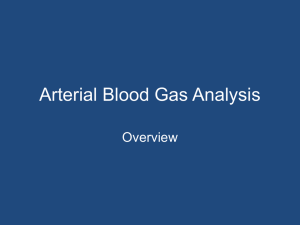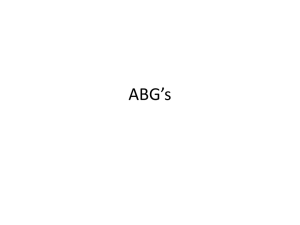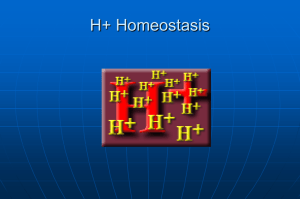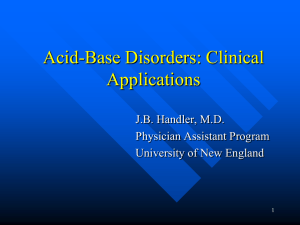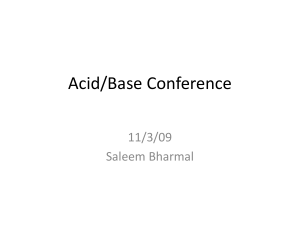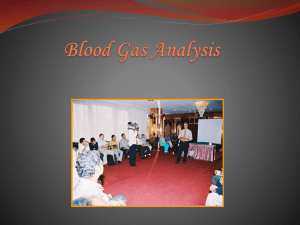Chapter 20b
advertisement
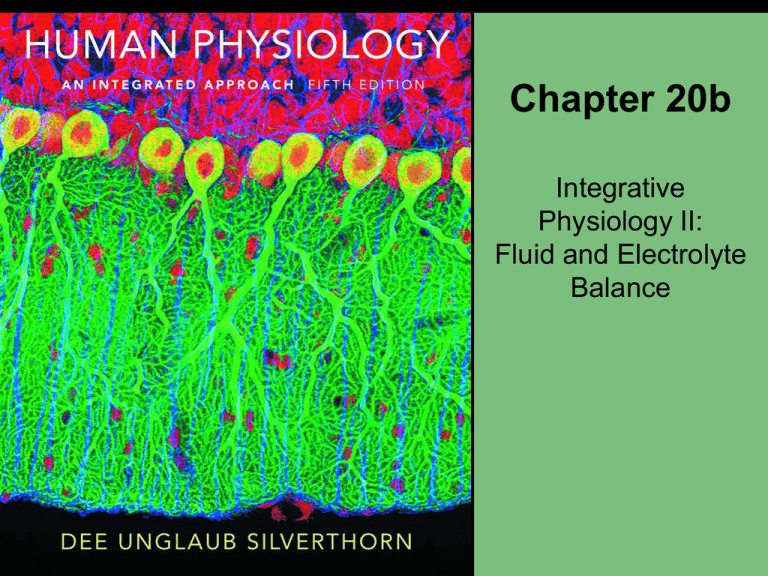
Chapter 20b Integrative Physiology II: Fluid and Electrolyte Balance Potassium Balance • Regulatory mechanisms keep plasma potassium in narrow range • Aldosterone plays a critical role • Hypokalemia • Muscle weakness and failure of respiratory muscles and the heart • Hyperkalemia • Can lead to cardiac arrhythmias • Causes include kidney disease, diarrhea, and diuretics Behavioral Mechanisms • Drinking replaces fluid loss • Low sodium stimulates salt appetite • Avoidance behaviors help prevent dehydration • Desert animals avoid the heat Disturbances in Volume and Osmolarity Figure 20-16 Volume and Osmolarity Table 20-1 (1 of 3) Volume and Osmolarity Table 20-1 (2 of 3) Volume and Osmolarity Table 20-1 (3 of 3) Volume and Osmolarity • Homeostatic compensation for severe dehydration Blood volume/ Blood pressure DEHYDRATION CARDIOVASCULAR MECHANISMS accompanied by RENAL MECHANISMS RENIN-ANGIOTENSIN SYSTEM + Carotid and aortic baroreceptors + + Granular cells CVCC Flow at macula densa HYPOTHALAMIC Hypothalamic MECHANISMS osmoreceptors Atrial volume receptors; Carotid and aortic baroreceptors + + Volume conserved Renin Angiotensinogen Parasympathetic output GFR Osmolarity Sympathetic output Hypothalamus + ANG I Vasopressin release from posterior pituitary ACE + + + Heart + Arterioles ANG II Thirst + Adrenal cortex Vasoconstriction Rate osmolarity inhibits Force Aldosterone Peripheral resistance Distal nephron Distal nephron Na+ reabsorption Cardiac output Blood pressure H2O and reabsorption Volume H2O intake Osmolarity Figure 20-17 Volume and Osmolarity Blood volume/ Blood pressure DEHYDRATION accompanied by Osmolarity RENAL MECHANISMS RENIN-ANGIOTENSIN SYSTEM + + + Granular cells CVCC Flow at macula densa + Volume conserved Renin Angiotensinogen Parasympathetic output GFR + Sympathetic output ANG I Vasopressin release from posterior pituitary ACE + + + Arterioles ANG II Thirst + Adrenal cortex Vasoconstriction osmolarity inhibits Aldosterone Peripheral resistance Distal nephron Distal nephron Na+ reabsorption Blood pressure H2 O and reabsorption Volume H2 O intake Osmolarity Figure 20-17 (5 of 6) Volume and Osmolarity Blood volume/ Blood pressure DEHYDRATION accompanied by RENAL MECHANISMS RENIN-ANGIOTENSIN SYSTEM CARDIOVASCULAR MECHANISMS + Carotid and aortic baroreceptors + + Granular cells CVCC Flow at macula densa HYPOTHALAMIC MECHANISMS Hypothalamic osmoreceptors Atrial volume receptors; Carotid and aortic baroreceptors + Volume conserved Renin Angiotensinogen Parasympathetic output GFR + Osmolarity Sympathetic output Hypothalamus + ANG I Vasopressin release from posterior pituitary ACE + Heart + + + Arterioles ANG II Thirst + Adrenal cortex Vasoconstriction Rate osmolarity inhibits Force Aldosterone Peripheral resistance Distal nephron Distal nephron Na+ reabsorption Cardiac output Blood pressure H2 O and reabsorption Volume H2 O intake Osmolarity Figure 20-17 (6 of 6) Acid-Base Balance • Normal pH of plasma is 7.38–7.42 • H+ concentration is closely regulated • Changes can alter tertiary structure of proteins • Abnormal pH affects the nervous system • Acidosis: neurons become less excitable and CNS depression • Alkalosis: hyperexcitable • pH disturbances • Associated with K+ disturbances Acid-Base Balance • Hydrogen ion and pH balance in the body Fatty acids Amino acids H+ input CO2 (+ H2O) Lactic acid Ketoacids Plasma pH 7.38–7.42 Buffers: • HCO3– in extracellular fluid • Proteins, hemoglobin, phosphates in cells • Phosphates, ammonia in urine CO2 (+ H2O) H+ output H+ Figure 20-18 Acid and Base Input • Acid • Organic acids • Diet and intermediates • Under extraordinary conditions • Metabolic organic acid production can increase • Ketoacids • Diabetes • Production of CO2 • Acid production • Base • Few dietary sources of bases pH Homeostasis • Buffers • Moderate changes in pH • Combines with or releases H+ • Cellular proteins, phosphate ions, and hemoglobin • Ventilation • Rapid response • 75% of disturbances • Renal regulation • Slowest of the three mechanisms • Directly excreting or reabsorbing H+ • Indirectly by change in the rate at which HCO3– buffer is reabsorbed or excreted pH Disturbances by Law of Mass Action Negative feedback Carotid and aortic chemoreceptors Plasma PCO2 Central chemoreceptors Respiratory control centers in the medulla Action potentials in somatic motor neurons Negative feedback • The reflex pathway for respiratory compensation of metabolic acidosis Plasma H+ ( pH) Muscles of ventilation Rate and depth of breathing Plasma H+ ( pH) by Law of Mass Action Plasma PCO2 Figure 20-19 pH Disturbances • Overview of renal compensation for acidosis Acidosis pH = H+ Nephron cells HPO42– filtered Blood CO2 + H2O Carbonic Anhydrase H+ secreted H+ + HCO3– H+ H2PO4– Excreted in urine Amino acids + NH4+ H+ HCO3– reabsorbed HCO3– buffer added to extracellular fluid Figure 20-20 Renal Compensation: Transporters • • • • • Apical Na+-H+ exchanger (NHE) Basolateral Na+-HCO3– symport H+-ATPase H+-K+-ATPase Na+-NH4+ antiport Renal Compensation • Proximal tubule H+ secretion and the reabsorption of filtered HCO3– Glomerulus Bowman’s capsule Interstitial fluid Peritubular capillary 1 Na+-H+ antiport secretes H+. Filtration HCO3– Proximal tubule cell Na+ 3 CO2 diffuses into cell and combines with water to form H+ and HCO3–. 1 Na+ Secreted H+ 4 Na+ H+ + 4 H is secreted again and excreted. Na+ Filtered HCO3– + H+ 2 + 2 H in filtrate combines with filtered HCO3– to form CO2. HCO3– Na+ HCO3– 5 CA 3 H2O + CO2 CO2 + H2O CA H+ + HCO3– Reabsorbed 6 Glutamine 7 Secreted H+ and NH4+ will be excreted NH4+ Na+ KG 5 HCO3– is reabsorbed. 6 Glutamine is metabolized to ammonium ion and HCO3–. 7 NH4+ is secreted and excreted. HCO3– HCO3– Na+ Na+ 8 8 HCO3– is reabsorbed. Figure 20-21 Intercalated Cells • Type A intercalated cells function in acidosis Figure 20-22a Intercalated Cells • Type B intercalated cells function in alkalosis Figure 20-22b Acid-Base Balance Table 20-2 Summary • Fluid and electrolyte homeostasis • Water balance • Vasopressin, aquaporin, osmoreceptors, countercurrent multiplier, and vasa recta • Sodium balance • Aldosterone, principal cells, ANG I and II, renin, angiotensinogen, ACE, and ANP • Potassium balance • Hyperkalemia and hypokalemia Summary • Behavioral mechanisms • Integrated control of volume and osmolarity • Acid-base balance • Buffers, ventilation, and kidney • Acidosis and alkalosis • Intercalated cells


